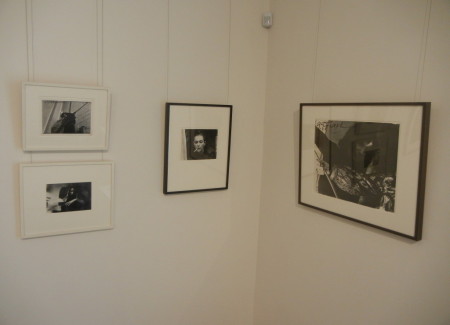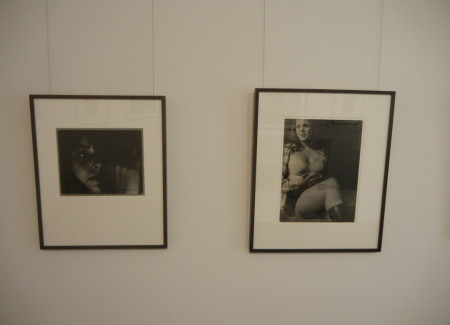JTF (just the facts): A total of 19 photographic works (17 single images and 2 sets of 4 images mounted together), framed in grey/black/white and matted, and hung against white walls in the single room gallery space. All of the works are vintage gelatin silver prints, made c1960s and 1970s. The prints are sized between roughly 9×7 and 24×20 (or reverse). Most are boldly signed in ink and stamped with the photographer’s copyright stamp across/on the surface, some multiple times. (Installation shots below.)
Comments/Context: We’ve reached a point in digitally-executed contemporary photography where almost by definition, unless the artist has taken a consciously hand-crafted detour, every print is perfect. Perfect in the sense of being effectively identical to any print other of the same image, without the need for any kind of knowledge or connoisseurship to identify the nuances – unless there have been some obvious condition issues, there are no nuances to interpret or discuss. We can assume prints of the same edition are for all intents and purposes “the same”.
With this modern reality lodged in my brain, Gerard Petrus Fieret’s prints from the 1960s and 1970s look positively, and wonderfully I might add, eccentric. They are crumpled and folded and haphazardly left-on-the-floor messy, having been treated with the reverse of the white cotton glove respect and reverence we typically apply to art objects. But in their loose, rough, unique imperfection, there is authentic charm to be found, and a kind of underground, experimental impulse that throbs in the background.
Fieret is perhaps best known for his many pictures of women, and depending on your perspective, it’s possible to see elements of both melancholy romance and leering eroticism in his intimate nudes and portraits. To my eye, his photographs routinely fall somewhere near quietly obsessive fascination, bewitched by a continual wonder at the mysteries of the female gender, where a tossed off look over a shoulder or a more sultry gaze through falling hair can be even more evocative than obvious curves and expanses of flesh. He never seems to tire of looking at women (whoever they are and whatever their charms), or of seeing their individual beauty.
Set in brooding darkened rooms and threadbare apartments and often lit by single bare bulbs, Fieret’s pictures make the most of the sparse interior surroundings, turning enveloping darkness into a friend rather than an enemy. Like low bar light, highlights and shadows become mood enhancers, where stolen glimpses allow us to imagine the rest. Fieret then goes on to add layers of process-centric solarization or double exposure, tweaking the intimate reality a notch or two further.
As seen in the handful of self-portraits on view here, Fieret was clearly an unassuming, oddball character. He alternately slumps in a bowler hat and squats stark naked in his apartment, trying out various looks and poses and then recasting the results with different photographic techniques. Fieret’s “signature” expression was his signature itself – again and again, his name is scrawled directly across his images, often with big, bold, gestural flourishes. To these interventions he added a manic stamping effect, splashing his rubber stamp copyright notice on images multiple times. This had the double effect of pointing out his artistic innovations and the details of his models, as if he was emphatically saying “mine, mine, mine, and mine” to both the visual ideas and the bodies, with thump after fixated thump of the stamp.
Two composite works on view made up of four prints each take Fieret out of the single frame into collections of images, allowing him to play with more abstract temporal and visual associations. Not knowing the faces in the pictures, it is hard to be certain about the relationships of the women, babies, hair dryers, and legs, but the collages are clearly something other than ordinary album pages in terms of their allusions and echoes. They feel like snippets of memories and emotions folded together over time, like links or stages.
While a sexy woman in bra and boots might seem to epitomize a swinging 60s vibe, Fieret was at his best when he was less direct. It was the marginal fleeting glance that was always the most seductive, especially when he allowed it to simmer in his imagination. Pushed further by his conscious experimentation, the best of his works feel like hallucinations – knowing delusions or fantasies perhaps at some level, but still complex and ephemeral in their enchantments.
Collector’s POV: The single image works in this show are priced between $1200 and $20000, while the two four-print sets are $20000 each. While Fieret’s work has surfaced in the secondary markets from time to time, the small number of transactions make it difficult to chart much of a price history. As such, gallery retail likely remains the best option for those collectors interested in following up.













Do you still sell some of his work?